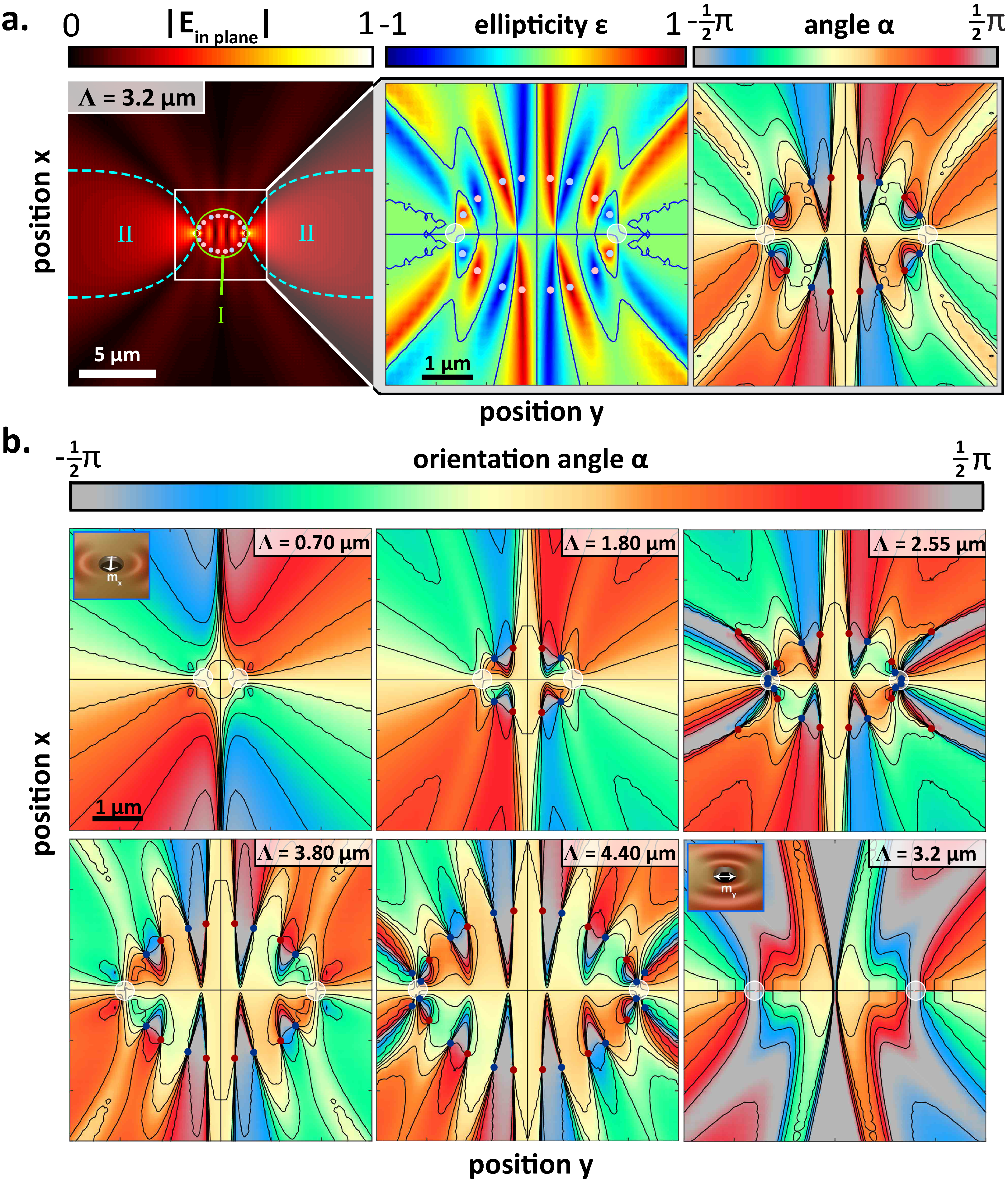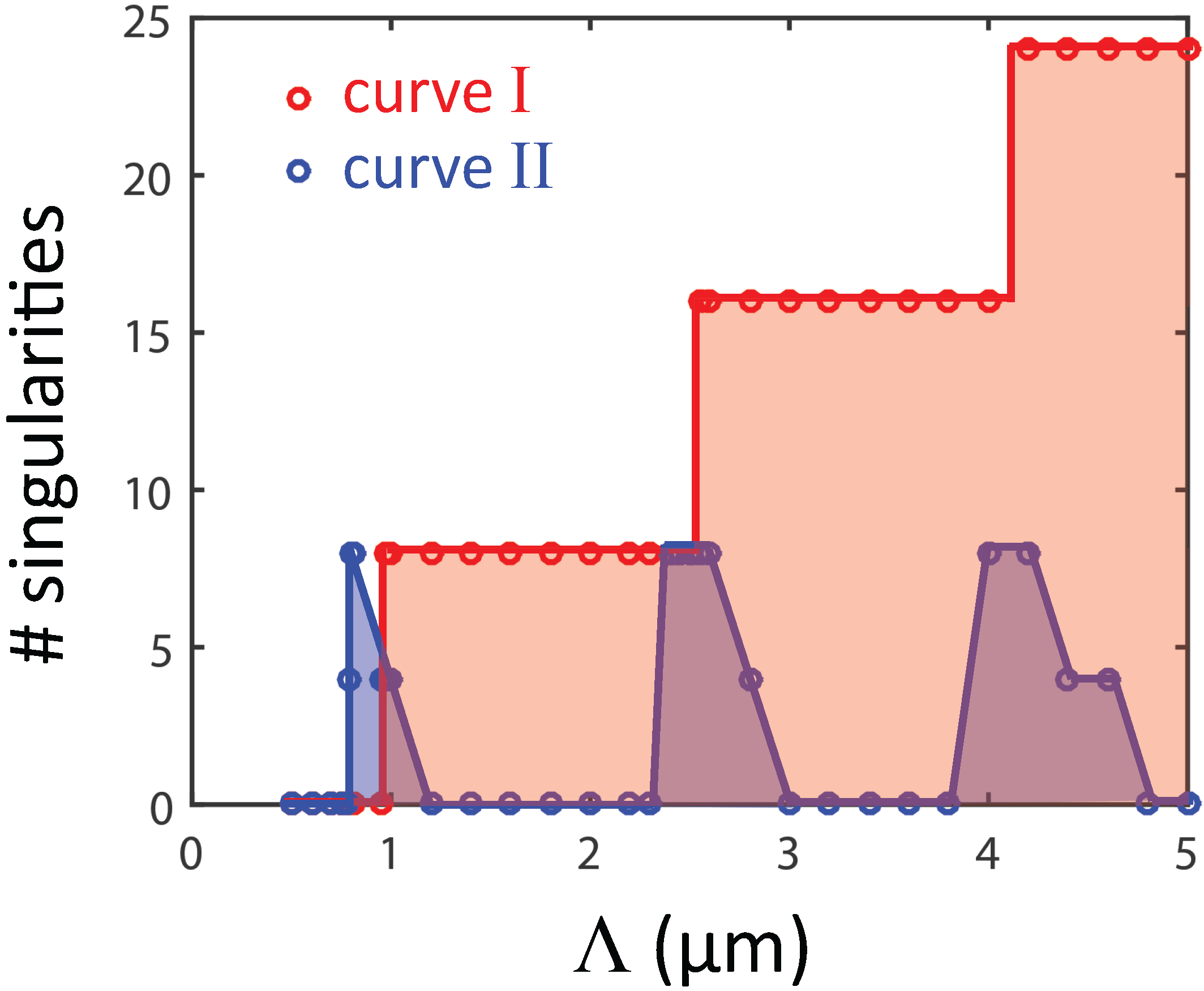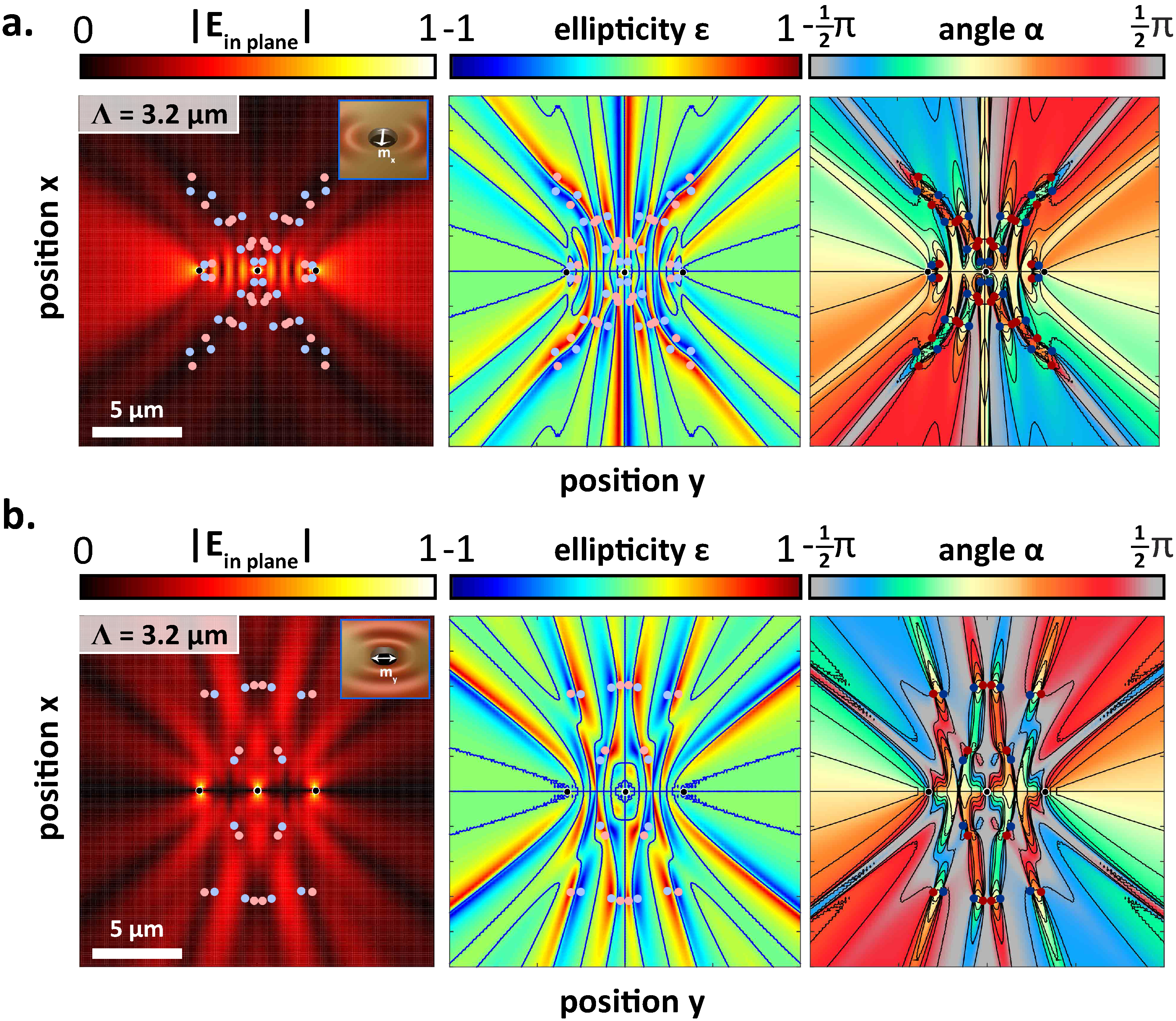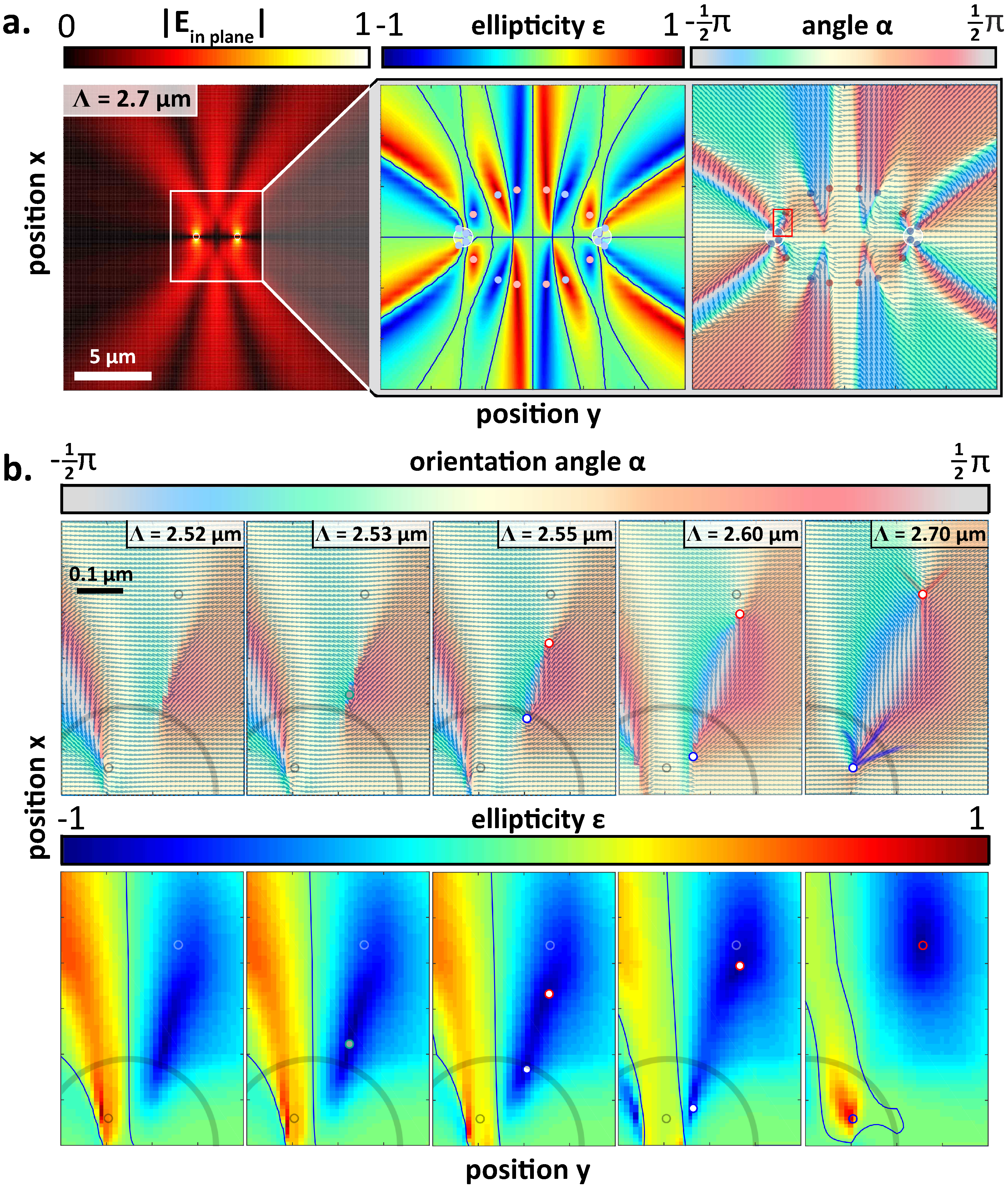3.1. Two Holes
We begin by considering the case shown in
Figure 1c, with two holes separated by
μm and the incident polarization chosen such that
, and the holes can interact with each other. The in-plane light field distribution of the SPPs, 20 nm above the gold surface, is shown in
Figure 2a, where, in addition to the electric field amplitude, we also show the ellipticity and orientation distributions.
Figure 2.
Light field maps for different plasmonic systems. (a) The in-plane electric field amplitude map, along with zoomed in maps of the ellipticity and orientation of the polarization ellipse, for two holes separated by 3.2 μm, with initial excitation . In the field amplitude map, we show two curves, an ellipse and two parabolas, along which we find polarization singularities. In this figure, we see C-points along I only, and we color code them according to their topological charge, with blue being and red . We also present ε and α maps in a smaller region of the central area around the holes. For ε, we mark the linear (L)-lines with solid curves, while for α, we likewise show the isogyres. (b) α maps, with circular (C)-points marked in solid symbols as in (a), for Λ ranging from 0.70 μm, where we see no C-points, to 4.40 μm, where we see 28 C-points (24 on I and four on ) in our field of view. The last frame shows the case of μm for excitation.
Figure 2.
Light field maps for different plasmonic systems. (a) The in-plane electric field amplitude map, along with zoomed in maps of the ellipticity and orientation of the polarization ellipse, for two holes separated by 3.2 μm, with initial excitation . In the field amplitude map, we show two curves, an ellipse and two parabolas, along which we find polarization singularities. In this figure, we see C-points along I only, and we color code them according to their topological charge, with blue being and red . We also present ε and α maps in a smaller region of the central area around the holes. For ε, we mark the linear (L)-lines with solid curves, while for α, we likewise show the isogyres. (b) α maps, with circular (C)-points marked in solid symbols as in (a), for Λ ranging from 0.70 μm, where we see no C-points, to 4.40 μm, where we see 28 C-points (24 on I and four on ) in our field of view. The last frame shows the case of μm for excitation.
![Photonics 02 00553 g002]()
We observe in the field amplitude map that the scattering of SPPs is directional, with most of the light flowing in the
direction, as expected for holes primarily characterized by
dipoles. Furthermore, in this amplitude map, we observe side lobes, whose angular position is determined by the interference of the SPPs radiated by the two holes. We note that, as shown in Equation
4, the plasmonic field simply decays exponentially with
z, and hence, only the amplitude, but not
ε or
α, of the field distributions shown in these maps depends on height.
We hunt for C-points, in the plasmonic field radiated by the holes, by looking at the
α map (
Figure 2a, last panel). In this map, we follow isogyres, lines of constant
α, shown with black curves, to their intersections, where
α is necessarily undefined, and a C-point is found. For the scattering event shown in
Figure 2a, we find 16 C-points that are roughly arranged in an ellipse, with the holes at the tip of the long axis. It is interesting that even such a simple system, with only two holes, can contain such a large number of singularities, and it is particularly useful that some C-points can be almost 2
μm away from the holes. Such relatively large separations are desirable, since, near the hole, other fields, such as cylindrical waves [
26], can be present, affecting the field distributions.
When we examine the electric field distributions at, and near, the C-points, we find that, as expected, the C-points occur at locations where
(
Figure 2a, middle panel). Moreover, we find the singularities in pairs, where each pair contains one singularity with a topological index (Equation (
3)) of
and one of
, which we mark with blue and red symbols, respectively. Hence, the total topological index of the light field is zero.
Having established that, with just two subwavelength holes, we can create electric field distributions that contain multiple C-points, we set out to test the tunability of our system. We begin by varying the separations of the holes, Λ, from 0.6 to 5.0
μm, and calculating the resulting electric field distributions. In
Figure 2b, we show a selection of the resultant
α maps, in order of increasing Λ. From these images, it is immediately clear that simply changing Λ can greatly affect the resultant light fields, and in particular, we note that the complexity of the
α maps increases with larger hole separations.
Moreover, we observe a dramatic change in the number of C-points that can be found in each map (
Figure 2b). For example, for
μm, we do not find any C-points, while for
μm, we find eight C-points, and for
μm, we find 16 C-points, and so on. This trend is summarized in
Figure 3, where it is clear that we find plateaus of Λ where the number of C-points present in the electric field distribution is a constant multiple of eight.
Moreover, in all of these cases, the C-points are found on the ellipse described above, which we sketch out in
Figure 2a and mark by curve
I. The discrete step size (eight singularities) with which C-points appear can be understood as follows: our plasmonic system has two axes of symmetry (
and
), which lead to a four-fold symmetry of the scattered SPP fields (as is evident from the consideration of a single hole, in Equation (
4)). Hence, we expect that if the singularities are created away from the symmetry axes, as is the case here, they will appear at four locations simultaneously. Moreover, at each position of creation, two singularities with an opposite index must be created; otherwise, either the symmetry of our system or the conservation of the index will be violated. Hence, during a creation event, the symmetry of our system and the conservation of the index dictate that a total of eight new C-points appear. Interestingly, the width of each plateau is
, perhaps because, for multiple holes, this would be the threshold for diffraction orders to appear.
Figure 3.
Number of C-points in our field of view, for the plasmonic system introduced in
Figure 2, as a function of Λ, showing clear plateaus of multiples of eight. Both the C-points found along curve
I are shown (in red), as are those along curve
(in blue).
Figure 3.
Number of C-points in our field of view, for the plasmonic system introduced in
Figure 2, as a function of Λ, showing clear plateaus of multiples of eight. Both the C-points found along curve
I are shown (in red), as are those along curve
(in blue).
In the
α maps presented in
Figure 2b and in
Figure 3, we observe that something interesting occurs near transitions when the number of C-points increases. The transition is, in fact, not straight from
n to
C-points. Rather, at first, when a transition occurs, several extra C-points appear, which then disappear when the new,
plateau is reached. For example, when
μm (
Figure 2b, last image in the top row), we observe 20 C-points and not the 16 of the plateau (e.g.,
μm;
Figure 2b, first image bottom row). Interestingly, these ‘extra’ C-points are always found outside of the main C-point ellipse, on curve
, as marked in
Figure 2a, and first appear far away, at large
y values. These extra C-points then move closer and closer to the holes, until after the creation event, when, continuing on curve
, they again move out of our field of view. The creation of C-points will be discussed in more detail, in
Section 3.3 below.
Finally, we recall that it is also possible to change the excitation beam, such that
, corresponding to the last panel of
Figure 2b. In this case, the incident beam will predominantly excite the
dipole in the holes, and they will not interact. As expected for this incident polarization, SPPs are radiated by the holes predominantly in the
directions. More importantly, in the
α maps, an example of which is shown in the last image in the bottom row of
Figure 2b for
μm, we find no C-points. This is true for the entire range of Λ’s that we investigate (from
to
μm). That is, two plasmonic holes that, initially, scatter SPPs perpendicularly to the line on which they lie are not sufficient to create electric field distributions that support C-points. Moreover, using a two-hole plasmonic system, it is therefore possible to create and annihilate C-points simply by rotating the polarization of the excitation beam.
3.2. Three Holes
It is, of course, also possible to increase the number of holes in the gold film. We can preserve the symmetry of our system, even as we add holes, by placing the additional holes on the
line, along with the original two holes. The additional holes act as extra sources of SPPs, both initially or from secondary scattering events in the case of hole-hole interactions, resulting in more complex field distributions. We show examples of such fields (including the amplitude,
ε and
α), for the case of three holes separated by
μm, for initial excitation using
in
Figure 4a and
in
Figure 4b.
In these, we observe that the directionality of the scattering is still determined by the excitation, with SPPs being radiated primarily in the
direction for
excitation, and
vice versa, but that many more side lobes arise in comparison to the field profiles created by the two plasmonic holes (
Figure 2a).
Figure 4.
Light fields around three holes. Field amplitude, ε and α maps for three holes with 3.2-μm separations when the incident response of the holes is dominated by (a) and dipoles. Both sets of maps clearly contain many C-points.
Figure 4.
Light fields around three holes. Field amplitude, ε and α maps for three holes with 3.2-μm separations when the incident response of the holes is dominated by (a) and dipoles. Both sets of maps clearly contain many C-points.
Given the increased complexity of the electric field distribution for the three-hole systems, we could expect to find additional C-points therein, relative to the case when only two holes were present. In fact, searching the field maps for both the two- and three-hole systems reveals that this is the case: for example, for the two-hole system with
μm (
Figure 2a), we observed 16 C-points, while for the same Λ, when
(
Figure 4a), we now observe 56 C-points. Moreover, we see that when three holes are present, we find C-points at greater distances from the holes, particularly in the
direction. In essence, the SPPs scattered from the two outer holes can interfere with the field from the middle hole, at relatively large distances directly above (or below,
) it, to create circular polarized light.
Interestingly and in contrast to the case when only two holes were present, with three holes, we observe C-points even for
excitation, where the holes do not interact. In
Figure 4b, for example, we find 24 C-points, which is comparable to the number of C-points found for only two holes under
excitation at this separation. It is clear that, regardless of the excitation field orientation, light fields containing polarization singularities can be created with relatively few such sources.
3.3. Creation and Annihilation of C-Points
The simple way in which our plasmonic system can be used to create light fields that contain polarization singularities, and, more specifically, how nanoscale geometry controls these features, allows it to be used as a platform to study properties of these C-points. As a demonstration, we focus on the creation of C-points and study the evolution of the light fields as new singularities appear due to changes in geometry. Specifically, we consider the situation first shown in
Figure 2b and
Figure 3, where, near
μm, new C-points appear.
By
μm, whose field amplitude and polarization maps we show in
Figure 5a, the transition from eight to 16 C-points on curve
I has been completed. At
μm, we observe that the 16 C-points are arranged nicely in an elliptical curve and are found in pairs of opposite charge, where, in each pair, one C-point is found where
and the other where
. As we learned, from
Figure 2, the new C-points appear near the holes, and so, we now focus on a small area near the leftmost hole, as marked by the red rectangle in the
α map (Frame 3) of
Figure 5a, and we study the evolution of the light fields, as the C-point pair shown in this volume appears (
Figure 5b).
At hole separations before the appearance of the new C-point pair, for example at
μm, as shown in the first pane of
Figure 5b, we see no points where
α is undefined, in our region of interest. At
μm (second frame,
Figure 5b), however, something interesting occurs. This small change of separation, from 2.52 to 2.53
μm, is not enough to cause C-points to appear (at least, not within the resolution of our calculations), but it is enough to cause a point to appear in the
α map, where the orientation is somewhat jumbled. We mark this point with a green circle, and as we see from the subsequent frames, it is from this point that the light fields that contain the C-points evolve.
In fact, a further small increase in separation, to
μm (third frame,
Figure 5b), is sufficient to make C-points clearly visible in the polarization maps. We mark these with blue and red circles and note that they carry a topological index of
and
, respectively, ensuring that the total topological index of the light field is conserved in this creation process. Interestingly, both C-points are formed in regions where
; that is, although the C-points carry the opposite index, the light fields in their vicinities have only one handedness. This situation remains even for
μm (fourth frame,
Figure 5b), although as Λ increases, so too does the separation between the new C-points.
Figure 5.
Evolution of the electric field leading to the creation of C-point pairs. (a) The in-plane electric field amplitude map, along with zoomed in maps of the ellipticity and orientation of the polarization ellipse, for two holes separated by 2.7 μm, with initial excitation . In the ε and α maps, we mark the locations of the C-points, and for α, we also overlay the color map with vectors aligned along the direction of the long axis. Additionally, the region that contains the two C-points whose creation we investigate is marked in the α map. (b) The spatial evolution of ε and α for to μm, in the region marked in (a). In all panes, we show the outlines of the holes, which scans through the field of view with the change to Λ. In all panes, we also show the final positions of the two C-points (for μm). For μm, we mark the location where changes in the α map herald the formation of the C-points, which we subsequently also mark for larger separations. Finally, for , we also trace out the lines of constant α leading to the singularity, observing that the top C-point is a star singularity, while the bottom C-point is of the monstar variety.
Figure 5.
Evolution of the electric field leading to the creation of C-point pairs. (a) The in-plane electric field amplitude map, along with zoomed in maps of the ellipticity and orientation of the polarization ellipse, for two holes separated by 2.7 μm, with initial excitation . In the ε and α maps, we mark the locations of the C-points, and for α, we also overlay the color map with vectors aligned along the direction of the long axis. Additionally, the region that contains the two C-points whose creation we investigate is marked in the α map. (b) The spatial evolution of ε and α for to μm, in the region marked in (a). In all panes, we show the outlines of the holes, which scans through the field of view with the change to Λ. In all panes, we also show the final positions of the two C-points (for μm). For μm, we mark the location where changes in the α map herald the formation of the C-points, which we subsequently also mark for larger separations. Finally, for , we also trace out the lines of constant α leading to the singularity, observing that the top C-point is a star singularity, while the bottom C-point is of the monstar variety.
![Photonics 02 00553 g005]()
By
μm (last frame,
Figure 5b), the C-points are well separated and, interestingly, can now be found in regions of opposite handedness. The flip in handedness of the field in the area of the bottom C-point is interesting, because, for this to occur, it seems as though the C-point must cross an L-line; this view is supported by
Figure 5b, where up to separations of 2.60
μm, there is no L-line between the C-points, while it is clearly there when
μm. Such a crossing of a C-point and an L-line is, in fact, not possible, since on the L-line, the polarization of the light is linear and, hence, has a well-defined orientation. Consequently, a C-point cannot be found on an L-line.
A closer look at the evolution of the C-points after their creation, in high-resolution simulations, allows us to determine how the handedness of the bottom C-point in
Figure 5b flips. Initially, in the region shown in the figure, we observe two C-points on fields characterized by
. Outside our field of view, below the
y-axis, the situation is reversed, and two C-point on fields where
were created. The handedness of the field underlying each singularity is, in fact, unchanged as the singularity moves due to a tuning of Λ. Rather, as Λ is increased, the two C-points closest to the
y-axis—the one above, in our field of view, and the one below—switch partner singularities. Once this switch occurs, at
μm, each singularity pair contains fields of both handedness, which are separated by an L-line. We emphasize that, during this rearrangement, no C-points are created or annihilated (further details and images of the way that the C-points switch their partner singularity can be found in the Supplementary Information).
Finally, for the
μm frame in
Figure 5b, we trace the lines of constant
α in the vicinity of the C-points to identify the type of singularity. We see that the top singularity is a star-type C-point, identified by the three-fold symmetric straight lines that radiate away from the singularity, while the bottom point is monstar C-point, where, again, three straight lines radiate away from the singularity, though without the three-fold symmetry of the star. Interestingly, when further increasing Λ to, for example,
μm, we observe that the bottom C-point has transformed from a monstar to a lemon-type C-point (see the Supplementary Information). The evolution of the singularities, from the creation of a star-monstar pair to the subsequent transformation of the monstar to a lemon, confirms earlier predictions of this event [
19].








